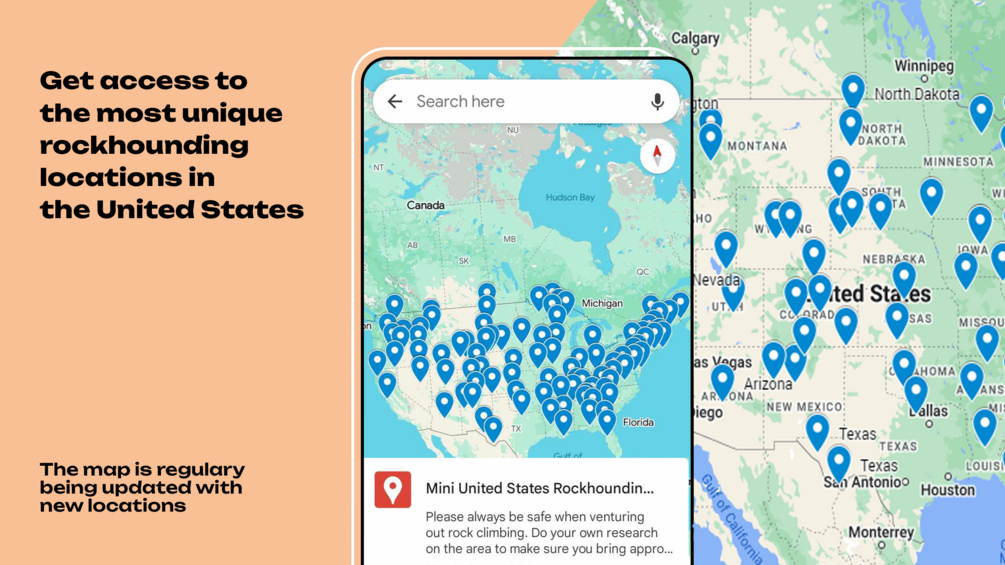North Carolina’s diverse geology isn’t just a treat for the eyes; it’s a treasure trove for rockhounding enthusiasts like you.
From the majestic Appalachian Mountains to the serene Piedmont plains, each region offers a unique bounty beneath the surface.
You’re in for a real adventure as you explore the hidden gems of the Tar Heel State.
Whether you’re after emeralds, sapphires, or the elusive gold nugget, North Carolina’s rich mining history means there’s plenty to discover.
North Carolina offers prime rockhounding locations like Franklin for rubies and sapphires, Hiddenite for emeralds and hiddenite gems, and Gold City for gold panning. Remember to check each site’s rules and use the proper tools for a successful and responsible rockhounding experience.
Get our FREE United States Rockhounding Map HERE

North Carolina Rockhounding Locations
Embarking on your adventure to uncover North Carolina’s geological treasures, you’ll find a plethora of sites across the state teeming with precious stones. Franklin, known as the Gem Capital of the World, offers an abundance of ruby and sapphire mines where you can dig for your own sparkling finds.
Hiddenite, a small town named after the gemstone that was discovered there, is home to the Emerald Hollow Mine. This unique destination is one of the only places in the world where you can find hiddenite gems. Plus, it’s also a hotspot for unearthing emeralds and sapphires.
For a touch of the past intertwined with a hunt for riches, head to Gold City, located in the Western mountains of North Carolina. This area allows you to pan for gold like the prospectors of the 1800s and possibly discover significant quartz rocks laden with gold.
- Emerald Hollow Mine: Offers sluicing, creeking, and digging options to find emeralds, hiddenite, and over 60 other types of gems and minerals.
- Mason’s Ruby & Sapphire Mine: Provides native, unsalted material where you can unearth rubies and sapphires in their true form.
- Cherokee Ruby & Sapphire Mine: No treated or enriched material here; expect to find authentic, untreated gemstones.
As you navigate through the state’s diverse famed locations, be sure to check the availability and requirements of each site. Most mines charge a fee for digging and require you to bring your own tools. It’s essential to respect the rules and regulations of each location to ensure that these treasures remain accessible to fellow enthusiasts and future generations.
Keep in mind that the thrill of rockhounding in North Carolina lies not only in the gems you can find but also in the memories you create while surrounded by the state’s natural beauty. Exploring these sites, you’re not just a visitor; you become part of North Carolina’s ongoing story, etching your name into the history of treasure seekers that have scoured this land far and wide.
What Gemstones are Found in North Carolina?

North Carolina’s diverse geological composition sets the stage for a rich variety of gemstones. Not only will you discover the rubies and sapphires in Franklin, but your treasure hunt might also lead to the state’s official gemstone, the emerald. Home to one of the most significant emerald deposits in North America, North Carolina’s Hiddenite area is a hotspot for green gem enthusiasts.
In addition to emeralds, amethyst, garnet, and aquamarine can be unearthed throughout the state. These semi-precious stones are part of the allure that brings both amateur and seasoned rockhounds to the Tar Heel State. If you’re venturing towards the southwestern regions, particularly around the counties of Macon and Jackson, keep your eyes peeled for sizable amethysts.
| Gemstone | Common Locations in NC |
|---|---|
| Ruby | Macon County (Franklin) |
| Sapphire | Cowee Valley |
| Emerald | Hiddenite |
| Amethyst | Southwestern NC |
| Garnet | Macon County |
| Aquamarine | Mitchell County |
A visit to the Brushy Mountains in the central part of the state might reward you with beautiful quartz crystals, including smoky quartz and citrine. These crystal-clear finds can be particularly captivating and are beloved for their unique qualities.
Bear in mind, some gemstones are more prevalent than others and can be found scattered in streams and rivers, making the panning method quite effective. Your rockhounding adventure could be enhanced by local gem festivals, which sometimes coincide with the best seasons for uncovering these natural treasures. So, you’ll want to plan your trip to capitalize on these events.
Exploring the rich soils of North Carolina not only opens up a world of rare and precious stones but also connects you to the geological history etched deep beneath the surface. Each find echoes the state’s unique mineralogical narrative. Always remember to respect the land you’re exploring and adhere to the regulations that protect these valuable resources.
What Sedimentary Rocks You Can Find in North Carolina?

As you explore the rich tapestry of North Carolina’s geological landscape, you’ll uncover a variety of sedimentary rocks – each with its own story of the Earth’s past. The state’s sedimentary rock deposits provide a glimpse into ancient environments and life.
Limestone is one of the prominent types of sedimentary rock you can find in North Carolina, especially in the mountainous regions. Limestone in North Carolina often contains marine fossils, evidencing the state’s underwater history millions of years ago. Areas such as the Murphy Marble Belt are well-known for their marble, which is a crystalline form of limestone.
In addition to limestone, you may also come across shale. Found mostly in the Piedmont and Mountain regions, shale is a fine-grained sedimentary rock formed from silt and clay. It can vary in color and is often seen in layers.
Sandstone is another sedimentary rock you’ll encounter in North Carolina. Notably, the state’s sandstone often appears in hues of brown and pink. You’ll find it used in local architecture due to its durability and aesthetics. Sandstone formations provide essential clues to the state’s ancient topography and climate conditions.
Lastly, you shouldn’t miss coal, found in sedimentary rock layers within the Deep River and Dan River basins. While not highly abundant, these coal deposits harken back to the lush, swampy forests that dominated the landscape during the Carboniferous period.
Keep these locations in mind for your rockhounding excursions:
- Murphy Marble Belt for limestone and marble
- Piedmont for its diverse shale formations
- Uwharrie Mountains for distinctive sandstone
What Metamorphic Rocks are found in North Carolina?
As you delve deeper into the world of rockhounding in North Carolina, you’ll discover that the state is a treasure trove of metamorphic rocks. The region’s dynamic geological history has paved the way for an impressive range of these transformed stones. Gneiss, schist, and slate are among the most commonly found metamorphic rocks here.
The Blue Ridge Mountains are particularly known for the abundant gneiss formations. This banded rock, created under intense pressure and heat, boasts intricate patterns that are fascinating to both novice and experienced rockhounds. Gneiss from North Carolina is typically composed of feldspar, quartz, and mica, with some variations containing eye-catching garnet inclusions.
In addition to gneiss, you’re likely to come across schist. This rock, often characterized by its sparkly mica flakes, provides a distinctive sheen that catches the light beautifully. Schist is predominantly found in the western parts of the state, where ancient tectonic activity transformed original sedimentary rocks into the stunning metamorphic varieties you see today.
Another rock to be on the lookout for is slate. Known for its use in roofing and flooring, this fine-grained rock forms from the metamorphosis of shale under relatively low-grade metamorphic conditions. Slate quarries can be found in the foothills of the Appalachian Mountains, where it’s often sourced for both decorative and structural projects.
Remember to bring your rock hammer, chisel, and safety goggles when on your quest for these metamorphic marvels. You’ll want to carefully extract samples while also ensuring your safety and maintaining the integrity of the natural sites. Be sure to verify if any specific areas require permission or have restrictions to collect specimens.
When exploring North Carolina’s metamorphic treasures, keep an eye on the textures and composition of the rocks you find. Each piece holds a story of immense geological forces that have shaped the land over millions of years. Whether it’s the wavy bands of gneiss, the shimmer of schist, or the layered appeal of slate, North Carolina’s metamorphic rocks are an open book to our planet’s transformative history.
What Igneous Rocks can You Find in North Carolina?
When embarking on your rockhounding journey throughout North Carolina, you’ll discover that the state is not only rich in metamorphic rocks but also in igneous varieties. The most notable are granite, pegmatite, and basalt. These rocks are primarily found in the Piedmont and Mountain regions, providing a vibrant terrain for enthusiastic rock collectors.
Granite is perhaps the most common igneous rock you’ll encounter. North Carolina’s granite is renowned for its large size and high quality, with the Stone Mountain being a prime location for sourcing this durable material. This stone is typically light-colored, composed mainly of quartz and feldspar, and it’s sought after for both construction and decorative purposes.
Moving on to pegmatites, these coarse-grained igneous rocks are treasure troves for rare minerals and gem-quality stones. Pegmatite formations can contain large crystals of feldspar, beryl, and mica, not to mention the possibility of uncovering gems like emeralds or aquamarines. The Spruce Pine Gemstone Mine is a notable destination for finding impressive pegmatite specimens.
Lastly, basalt – a fine-grained igneous rock – can also be found in certain parts of North Carolina. While less common than granite or pegmatite, basalt is significant for its role in the state’s ancient volcanic activity. Its typical dark-grey to black coloration is distinctive, with some specimens found near old volcanic sites in the Mountain region.
For the best rockhounding experience, make sure to research each site’s regulations and ensure you have the right permissions before collecting. Always bring your rock hammer, safety glasses, and gloves to safely extract and handle these often hard and heavy rocks. Remember, rockhounding is finding spots near you but also about preserving the natural beauty and integrity of these sites for future generations.
Panning for Gold in North Carolina
North Carolina’s rich history includes the first documented gold discovery in the United States, long before the California Gold Rush. Today, you can still pan for gold in various rivers and streams across the Tar Heel State. With the right equipment and a sharp eye, you might just strike it lucky.
Reed Gold Mine, located in Midland, is a historic site where gold was first found in 1799. It’s an ideal spot for beginners to learn the basics of gold panning. The mine offers panning tutorials and rents out equipment so you don’t need to worry about bringing your own.
If you’re up for an adventure, head to the Uwharrie River – known for its gold deposits. The river’s running waters have carried and deposited gold flakes along the banks, making it a favorable location for more experienced prospectors.
Ensure you are familiar with the laws regarding gold panning in North Carolina. While some streams and rivers are open to the public, others may sit on private land or require special permissions. Respect the rules and regulations to ensure that rockhounding remains a sustainable hobby for all.
- A gold pan
- A sluice box (for more serious endeavors)
- A classifier or screen
- A snuffer bottle
- Waterproof boots
With these items, you’ll be well-equipped to sift through sediment and separate gold flakes from other particulates. Remember that panning for gold is a patience-testing process, but it can be incredibly rewarding when you find that glint of yellow in the bottom of your pan. As you explore various sites, document your findings and experiences, adding to the collective knowledge base of North Carolina’s gold panning community. Keep an eye out for local clubs or gatherings, as these can be a great resource for tips and local knowledge that’ll help enhance your panning experience.
Rocks and Minerals Found in North Carolina
North Carolina is a veritable treasure trove for rockhounds. Your journey will likely uncover a wide range of minerals including the striking emerald, the deep red rhodolite garnet, and the impeccable quartz crystals. Many are unaware that North Carolina is the only source of hiddenite, a rich green gemstone named after the town of Hiddenite where it was first discovered.
These discoveries aren’t mere happenstance; the diverse geologic history of the state sets the stage for the variety of finds. The Blue Ridge Mountains and Piedmont regions, in particular, are renowned for their mineral deposits. Here’s an insightful peek at what you might come across:
- Emeralds: These coveted green gems are chiefly found at the Hiddenite Gem Mine.
- Rubies and Sapphires: Mainly located in the Cowee Valley in Macon County.
- Quartz: Abundant in the mountains, especially in the form of amethyst.
- Kyanite: Often discovered in the Spruce Pine District.
- Gold: Historically panned from rivers like the Uwharrie and at Reed Gold Mine.
For a detailed exploration, consider the following notable locales:
- Mason Mountain Mine: Offers a chance to discover rubies and sapphires.
- Cherokee Mine: Known for its variety of quartz crystals.
- Crabtree Emerald Mine: Affords opportunities to find emeralds and other minerals.
In North Carolina, it’s imperative to stay informed about the localities you plan to explore, ensuring each site’s rules and regulations are followed to the letter. Remember, several sites are on private property and require permission for access, while others might be part of national forests where collection is regulated.
Safety should be your top priority. Make sure you’re geared up with the right tools—a sturdy pair of gloves, resilient boots, and protective eyewear are non-negotiable for a successful and safe hunting expedition. Don’t forget a first aid kit for any unexpected incidents.
Engaging with local rockhound clubs can offer a wealth of knowledge on finding, collecting, and even cutting and polishing your finds. These communities are often the first to know about changes in access to sites and regulations, providing an invaluable resource for both novices and seasoned collectors alike.
Where Can I Find Fossils in North Carolina?
Seeking fossils can be as thrilling as the quest for precious gems and North Carolina is a haven for fossil enthusiasts. The coastal plains of the state hold ancient secrets dating back millions of years. You’ll find a range of fossilized remains from prehistoric marine life to remnants of ancient forests.
Aurora is renowned for its wealth of fossils. At the Aurora Fossil Museum, you can dig into piles of fossil-rich spoil from the nearby phosphate mine. It’s common to uncover teeth from the mighty Megalodon, the enormous prehistoric shark that once ruled the oceans. Besides these giant teeth, fossilized shells and remnants of extinct creatures are waiting to be found.
Greens Mill Run in Greenville provides a unique experience for fossil hunters. This small stream cuts through a variety of geological formations, bringing a mixture of fossils to the surface. You can expect to find shark teeth, whale bones, and even artifacts from early Native American civilizations. Keep in mind that the terrain at Greens Mill Run can be challenging, so come prepared with sturdy boots and digging tools.
For a glimpse into the Triassic period, head over to the Dan River Basin. This area is known for its Triassic fossils like phytosaur teeth and various reptilian remains. Access to the Dan River sites can be limited, so it’s best to check local access rights and guidelines before planning your trip.
Here’s what you might discover in key locations:
- Aurora: Megalodon teeth, belemnites, bivalves
- Greens Mill Run: Shark teeth, whale bones, Native American artifacts
- Dan River Basin: Phytosaur teeth, reptilian fossils
While these sites offer exciting fossil hunting opportunities, always remember to respect property boundaries and the natural environment. Whenever you set out, make sure you’re following state regulations and obtain any necessary permits or permissions. With careful planning and a keen eye, your next extraordinary find is just waiting to emerge from the sands of time in North Carolina.
North Carolina Rockhounding Laws & Regulations
When you’re ready to begin your rockhounding adventure in North Carolina, it’s imperative to familiarize yourself with the state’s specific laws and regulations. This knowledge not only ensures legal compliance but also protects the natural areas that provide these geological treasures.
First and foremost, permission is key. Whether you’re exploring private land or navigating public areas, always obtain the proper permissions before you start collecting. On private lands, connect with the landowner and secure written consent to avoid any legal issues. For public lands, check with local authorities as rules can vary significantly from one location to another.
National Forests and state parks generally have strict guidelines. Collecting rocks, minerals, or fossils may be prohibited or limited to small quantities for personal use only. Commercial collecting is typically not allowed without special permits. Keep in mind that using tools like shovels or picks might be restricted in these areas to prevent ecological disturbances.
In national forests within North Carolina, such as the Pisgah and Nantahala, rockhounding is allowed but with limitations. You’re usually limited to small amounts suitable for a personal collection. Removal of larger specimens or commercial collecting could land you in hot water without the proper permits.
Designated Rockhounding Areas have been established by various government bodies and may offer more lenient regulations. These areas exist to encourage hobbyists while still protecting natural resources. Familiarize yourself with their specific rules and hours of operation before planning your visit.
North Carolina isn’t just protective of its geological history; its cultural heritage is also safeguarded. Artifact hunting is heavily regulated, and removal of any Native American artifacts is illegal on both state and federal land. If you find an artifact, it’s best to leave it and report the location to the appropriate authorities.
Stay updated on the laws as they can change, and make sure you’re not inadvertently contributing to the degradation of the sites you visit. Your adherence to these guidelines ensures that rockhounding remains an enjoyable and sustainable pastime for future enthusiasts.
Rockhounding Tips for Beginners in North Carolina
Gearing Up: Essential Tools for Rockhounding
Before you head out to the diverse terrains of North Carolina, make sure you’re well prepared. Essential tools for a successful rockhounding trip include:
- Rock hammer for chipping and extracting samples
- Chisels and pry bars to help loosen stubborn rocks or specimens
- Safety glasses and gloves to protect your eyes and hands from sharp edges and debris
- Durable backpack or bucket to carry your finds
- Field guide to assist with identification on the go
Pack a GPS device or map of the area, and never underestimate the utility of a small shovel for digging and moving soil. Remember, lightweight equipment is your friend as you’ll often find yourself hiking to remote spots.
Safety Tips While Rockhounding
Your safety should always be a top priority during rockhounding. To ensure you’re protected, consider the following:
- Always tell someone your planned location and return time
- Check the weather forecast before departing and dress appropriately
- Carry sufficient water and snacks to stay hydrated and energized
- Be aware of wildlife and leave the area if you encounter dangerous animals
- Stay on marked trails to minimize your impact on the environment
Be attentive to your surroundings and avoid overexerting yourself, especially if you’re new to rockhounding.
Legal Guidelines for Rockhounding Enthusiasts
Before you start collecting rocks and fossils, familiarize yourself with North Carolina’s legal guidelines:
- Ask for permission before collecting on private lands
- Be aware of the restrictions in national forests and state parks
- Artifact hunting on state and federal land is strictly prohibited
To respect these regulations, always research and secure any necessary permits or permissions. Following these rules helps preserve natural sites for future generations and prevents legal complications. Keep abreast of any changes in legislation to stay compliant with state and federal rockhounding laws.
Conclusion: North Carolina Rockhounding Locations
Armed with the right tools and knowledge, you’re ready to explore North Carolina’s rich geological playground.
Remember to prioritize your safety and respect the legal boundaries of your treasure hunt. Stay informed about the latest laws and preserve the natural beauty for fellow enthusiasts. With every adventure, you’ll not only build your collection but also create unforgettable memories in the great outdoors. Now it’s time to put your rockhound skills to the test and discover what nature has hidden beneath the surface.
Happy rockhounding!


![Wyoming Rockhounding Sites in [year]: Jade & More Gems](https://observationhobbies.com/wp-content/uploads/2024/01/8Vd9NCMeQ44v5fUz8GV7r-768x439.jpg)


![Montana Rockhounding [year]: Best Locations & Treasures](https://observationhobbies.com/wp-content/uploads/2024/01/Montana-Rockhounding-768x525.png)

